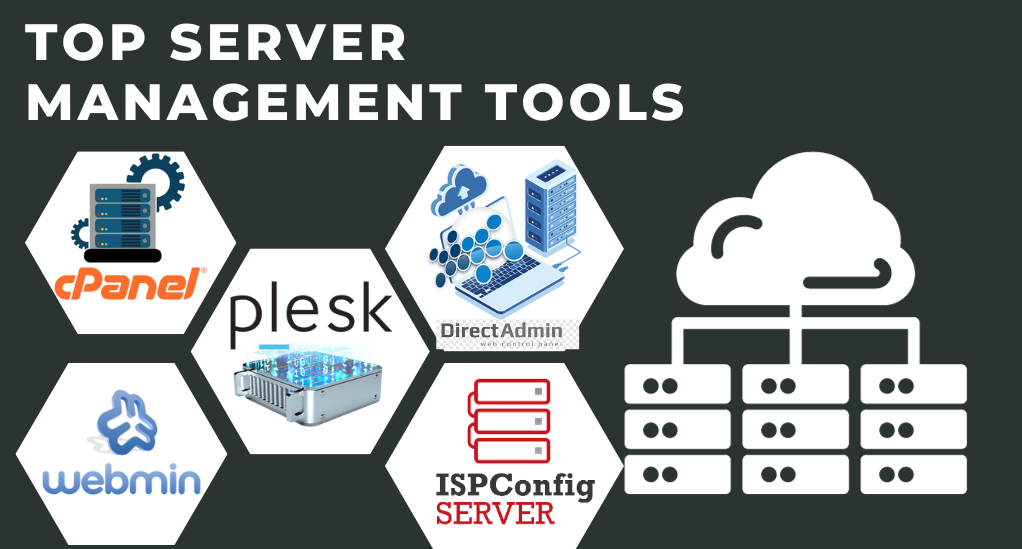
How to Choose the Right Server Management Tools
In the digital age, businesses are increasingly reliant on technology to drive their operations, reach their customers, and achieve their goals. At the heart of this technological revolution lies the server – the backbone of any IT infrastructure. Servers store, process, and deliver data, making them indispensable. However, as with any piece of technology, servers require regular maintenance and management to function optimally. This is where server management tools come into play.

What are Server Management Tools?
Server management tools are software applications designed to help IT professionals and system administrators monitor, configure, and maintain servers. These tools provide a centralized platform to oversee server health, performance, and security, ensuring that servers run efficiently and without interruption.
Why are they Important?
Imagine a bustling city with no traffic management. The result would be chaos, with frequent jams and accidents. Similarly, without proper server management, businesses can face downtime, data breaches, and inefficiencies. Here are a few reasons why server management tools are indispensable:
- Efficiency: These tools automate many routine tasks, freeing up IT personnel to focus on more strategic initiatives.
- Security: With cyber threats on the rise, server management tools provide essential security features, such as patch management and intrusion detection, to safeguard sensitive data.
- Performance Monitoring: Regular monitoring ensures that servers are running at optimal levels, and any issues are addressed promptly.
- Cost Savings: By preventing potential server failures and reducing downtime, businesses can avoid costly disruptions and maintain a positive brand image.
The Evolution of Server Management
Over the years, server management has evolved from manual, command-line-based processes to sophisticated software solutions with graphical interfaces. The early days of server management involved IT professionals physically accessing servers to make changes or troubleshoot issues. Today, with the advent of cloud computing and virtualization, servers can be managed remotely, and tasks can be automated, making the process more streamlined and efficient.
| Era | Server Management Approach |
|---|---|
| 1990s | Physical access, manual configurations |
| 2000s | Remote access, basic automation tools |
| 2010s | Advanced software solutions, cloud integration |
| 2020s | AI-driven management, predictive analytics |
Understanding Server Management
At its core, server management is the process of maintaining and operating a server to ensure its optimal performance, security, and availability. It encompasses a range of tasks, from basic system monitoring to advanced software updates and security patch installations.
Why is it crucial for businesses?
Every digital interaction, be it a website visit, an online transaction, or a simple email, relies on servers. For businesses, this means that servers play a pivotal role in ensuring smooth customer experiences, safeguarding data, and supporting daily operations. Here’s a deeper look into why server management is non-negotiable for businesses:
- Uptime Assurance: Downtime can be costly, both in terms of lost revenue and damaged reputation. Proper server management ensures high availability, minimizing the risk of unexpected outages.
- Data Protection: Servers often store sensitive information, from customer data to intellectual property. Effective server management tools offer robust security features to protect against data breaches and cyberattacks.
- Scalability: As businesses grow, so do their IT needs. Server management allows for scalability, ensuring that IT infrastructure can handle increased loads and demands without hiccups.
- Regulatory Compliance: Many industries have strict regulations regarding data storage and protection. Proper server management ensures that businesses remain compliant, avoiding potential legal repercussions.
Top Server Management Tools
In the vast landscape of IT, numerous server management tools cater to different needs. Here’s a brief overview of some of the most popular ones:
- cPanel: Best suited for small to medium-sized businesses, cPanel offers a user-friendly graphical interface for managing web hosting services. Its features include easy installation, robust security, and integration with popular web hosting providers.
- Plesk: A step up in terms of advanced features, Plesk provides multiple server management capabilities and supports various operating systems. Its advanced backup and security features make it a favorite among larger businesses.
- DirectAdmin: Lightweight and straightforward, DirectAdmin is perfect for businesses that need a no-frills, efficient server management tool. It boasts a user-friendly interface and integrates seamlessly with popular web hosting providers.
- Webmin: An open-source tool designed specifically for Linux servers, Webmin offers a free solution for businesses on a budget. Despite being free, it doesn’t skimp on features, providing advanced security and backup options.
- ISPConfig: Another open-source tool, ISPConfig, stands out with its multiple server management capabilities. It’s versatile, supporting multiple operating systems, making it ideal for diverse IT environments.

Delving into Server Monitoring Tools
While server management tools focus on the overall maintenance and operation of servers, server monitoring tools are specialized software designed to keep a vigilant eye on server performance, health, and security. They continuously collect data, analyze it, and provide real-time insights, ensuring that any potential issues are identified and addressed promptly.
Why Monitoring is Essential
- Proactive Problem Solving: Instead of reacting to issues after they’ve caused disruptions, monitoring tools allow IT teams to identify and address potential problems before they escalate.
- Optimized Performance: Regular monitoring ensures that servers are operating at their peak, leading to faster website load times, smoother application performance, and overall better user experiences.
- Resource Allocation: By understanding server workloads and performance metrics, businesses can make informed decisions about resource allocation, ensuring efficiency and cost-effectiveness.
Spotlight on Key Server Monitoring Tools
- Zabbix: An open-source monitoring solution, Zabbix is renowned for its flexibility. It can monitor various parameters, from server performance to network health. Key features include flexible data-gathering capabilities, support for distributed monitoring, and advanced alerting mechanisms.
- Nagios: A veteran in the monitoring space, Nagios offers a comprehensive monitoring solution, keeping tabs on servers, networks, and applications. Its easy-to-use configuration wizards, plugin architecture, and custom report generation capabilities make it a favorite among many IT professionals.
The Power of Server Automation Tools
In today’s fast-paced IT environments, automation is not just a luxury; it’s a necessity. Server automation tools streamline and automate repetitive tasks, from software installations to system updates, ensuring consistency and reducing human error.
- Ansible: A standout in the server automation realm, Ansible’s agentless architecture means there’s no need for additional software on the servers it manages. It supports multiple environments and offers cloud infrastructure management, making it a versatile choice for diverse IT setups.
- Puppet: Puppet takes automation to the next level with its focus on enforcing compliance with security policies and regulatory requirements. Its advanced scalability features make it suitable for large-scale deployments.
- SaltStack: Known for its speed, SaltStack offers fast remote execution capabilities, allowing actions across multiple servers in record time. Its event-driven infrastructure automation is a game-changer for complex workflows and deployments.
Factors to Consider When Choosing a Server Management Tool
Choosing the right server management tool is akin to selecting the right partner for a long-term relationship. It’s a decision that can significantly impact your business’s IT operations. Here are some pivotal factors to consider:
- Your Organization’s Specific Needs: Before diving into the myriad of options available, outline what you need from a server management tool. Are you looking for basic monitoring, or do you need advanced automation features? Understanding your requirements will narrow down your choices.
- Scalability and Future Growth: Your chosen tool should be able to grow with your business. As your IT infrastructure expands, the tool should be capable of handling increased loads and more complex tasks without requiring a complete overhaul.
- Security Features and Compliance Requirements: In an era where cyber threats are rampant, security cannot be compromised. Ensure that the tool offers robust security features, including regular updates, patches, and compliance with industry regulations.
- Cost and Budget Considerations: While it’s essential to invest in a reliable server management tool, it’s equally crucial to ensure that it aligns with your budget. Consider both the initial investment and any recurring costs.
- User Interface and Usability: A tool with a steep learning curve can slow down operations. Opt for a solution that’s user-friendly, intuitive, and doesn’t require extensive training.
- Integration Capabilities: Your server management tool should seamlessly integrate with other tools and platforms you use. This ensures a cohesive IT environment where different solutions work in tandem.
- Customer Support and Community: A responsive customer support team can be invaluable, especially during critical situations. Additionally, a vibrant community can offer insights, tips, and solutions to common challenges.
The Role of Hosting Providers in Server Management
While server management tools play a pivotal role, the importance of a reliable hosting provider cannot be understated. A hosting provider lays the foundation upon which your entire online presence is built.
- TezHost: As an example, TezHost offers a blend of reliability, speed, and security. With server locations spanning Finland, the USA, and Germany, they provide a global reach. Their high uptime guarantee, advanced security features, and 24/7 customer support make them a top choice for businesses of all sizes.
Conclusion
Server management is an intricate dance of monitoring, maintenance, and continuous improvement. With the right tools in hand, businesses can ensure that their IT infrastructure runs smoothly, securely, and efficiently. As technology continues to evolve, the importance of server management will only amplify. By investing time and resources in selecting the perfect tool today, businesses can pave the way for a technologically robust future.


Leave a Reply